The Tower of London – The Key to English History
It’s February and it’s cold, but its London, so who cares? I’m off with my adult daughter Lenore to visit the Tower of London. She’s never been there before and even though I have, there’s definitely a tingle of excitement that I always get on visiting a place that is so steeped in history. In fact if one were to elect a poster child for ‘famous landmarks’, the Tower of London would be an excellent candidate. But first a couple of tips that might make an upcoming visit more enjoyable.
On a previous post I wrote about the potential benefits of buying a London Pass. The Tower of London at £25.00 is one of the more expensive attractions in London and definitely one you would want to include if you’ve purchased a London Pass. With the pass you get to avoid the lineups at the ticket wicket and go directly to the entrance. Also if you take the Hop on Hop Off bus that’s included in a one day London Pass you get a great view of the Tower of London as you drive across the Tower Bridge from Southwark.
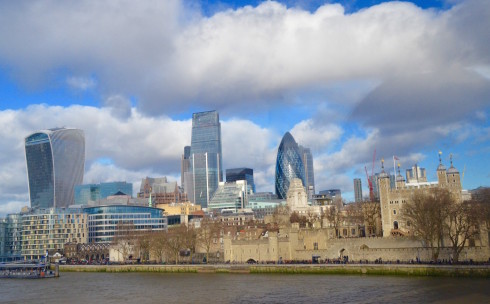
The other alternative is to buy your ticket online which will save a few pounds. Make sure to do it far enough in advance that it can be mailed to you, otherwise you’ll waste time in line picking it up at the ticket office. The last alternative is to simply show up and buy a ticket at full price, but expect to queue up. Approaching the Tower of London from the Hop On Hop Off bus stop you get this great contrast between the new and the old. That’s The Shard, the tallest building in Western Europe on the right.
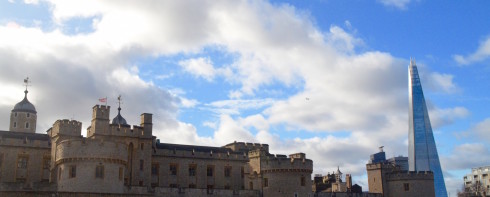
I wish I could give some good advice on the best time of year or day to visit the Tower of London, but things have changed dramatically in the last few years with the explosion of Chinese tourists. While there are going to be a lot fewer visitors in the winter months, in all likelihood the tower will be inundated almost anytime you visit. Usually getting there at opening time (9:00 Tuesday-Saturday, 10:00 Sunday and Monday) is the best advice. Lot’s of people suggest immediately rushing off to see the Crown jewels, but unless it’s totally insane, that seems too much like a Disneyworld ploy.
UPDATE:
With the pandemic closing most of London’s attractions, there’s a good chance that once it is over the number of tourists will be drastically reduced and visiting the Tower of London might be easier than it’s been for decades.
Ways to visit the Tower of London
Once you are inside there are more choices to be made. You can a) just explore the place on your own – not recommended b) join a free guided tour led by a Yeoman Warder – that’s a Beefeater to most of us or c) rent an audioguide for £5. The guided tours last one hour and are definitely not to be missed. The Yeoman or in at least one case Yeowoman, are funny, irreverent and informative. You’ll definitely hear things you won’t hear on the audiotour. However, there is one huge caveat – the number of people on the tour is not restricted so that sometimes the crowds are so big that it is next to impossible to hear the guide unless you are aggressively prepared to elbow your way to the front. My best advice is to go to the collection point for the next tour, which is right after you enter, and see how many people are waiting. If the number on the tour is twenty or less, go for it, but more than that will be problematic. The guided tour does not include the Crown jewels or the White Tower so you can do those after the tour. Even if you decide to skip the tour make darned sure you get that obligatory picture with a Yeoman.
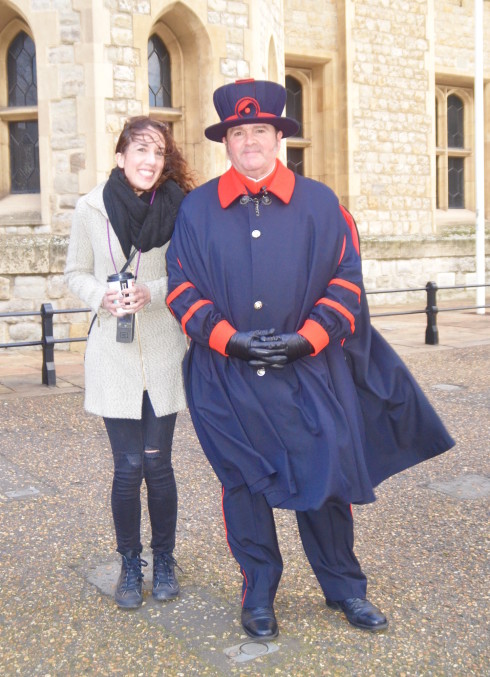
Wait, you’re probably thinking. I’ve drank enough gin to know that this guy should be dressed in red, not blue! Well actually the blue is the official uniform and red worn only on ceremonial occasions.
That brings us back to option c, the audioguide and in my opinion, with or without a guided tour, the definite best way to get the most out of your visit.
Famous people and the Tower
OK, after nearly 650 words I’m ready to write about the Tower of London. What’s the big deal anyway? Well think of William the Conqueror, Richard the Lion-Hearted, bad old King John, Henry III, the boy king who reigned for fifty-six years, Edward I (aka Longshanks, the Hammer of the Scots and anyone else who got in his way), Henry VII the winner of the War of the Roses and of course, perhaps most famous of all, Henry VIII. These were the winners, but to put it a bit crudely, a lot of bad shit went down here as well. Two kings, Henry VI and Edward V as well his little brother were murdered here. Anne Boleyn, Catharine Howard and Lady Jane Grey all lost their heads inside these walls. The list of famous prisoners is legion – numerous Scottish kings, William Wallace of Braveheart fame, three saints including Thomas More, Thomas Cranmer, Sir Walter Raleigh, Guy Fawkes, Samuel Pepys, William Penn, the future first prime minister Sir Robert Walpole and even Queen Elizabeth I. And it wasn’t just a prison in olden times. In the 20th century Irish patriot Roger Casement was imprisoned after the Easter Rebellion, numerous WWII German spies were shot here and Rudolf Hess was brought here after defecting from Hitler in 1941. Among the last of the prisoners held in the Tower of London were the infamous criminals, the Kray twins, held not for being murderous thugs, but for dodging the draft.
I mean if there was ever a place where the saying, “If only these walls could speak” was appropriate it would be here. And actually, in a sense, as we shall see, the walls do speak through the graffiti that has been scratched into them by hundreds of unfortunate souls.
The audio guide provides five distinct tours including the Norman era, the Medieval times and the tower as a place of punishment and execution. However, even before beginning the audio tour you are bound to notice that the outer walls of the Tower of London facing the Thames is maybe the best spot in the city to get a good shot of the Tower Bridge, arguably the most recognizable bridge in the world. And for you nitpickers, yes this picture was taken just outside the walls, but the view from the walls is just as good or better.
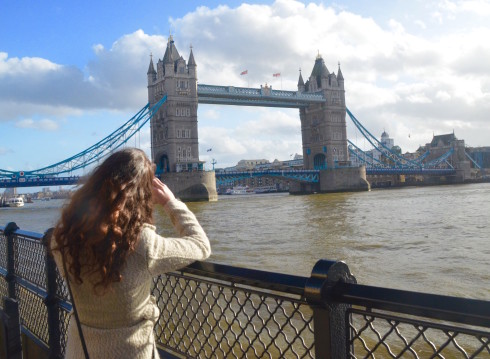
History of the Tower of London
The history of the Tower of London really goes back over a thousand years before William conquered England in 1066 at the Battle of Hastings. It was the Romans who put London or Londinium as they called it on the map and here’s what it looked like in about the year 100. Being the incredible engineers they were, the Romans built the first bridge over the Thames at London and it would not be for another 1600 years that a second one was built.

Anyway, by the time William arrived on the scene the Roman city was long gone, but remnants of the ancient fortifications remained and you can still see them at the base of the White Tower today. The conquest of England by the Normans is arguably the most important turning point in British history. Never again would England undergo such a transformation, despite efforts by the Spanish, the French and the Germans over the centuries (although in the interests of accuracy the Dutch kind of did it through the back door in 1688). Prior to William’s conquest England had been a regular doormat for the Celts, the Danes, the Saxons, the Norwegians, the Scots, the Angles, the Jutes and of course, the Romans. The English were the Toronto Maple Leafs of fighting forces. Anyone could beat them.
William decided to change that and it started right here in the Tower of London with the construction of the White Tower, which I suspect most people confuse with actually being the Tower of London, when it’s only one part, albeit the most recognizable one. Nobody had ever built such a huge fortress in England before and it became an immediate symbol of dominance and strength. Note the wooden stairs that go to a second story entrance. These could be removed if the place was attacked. We’ll take a look inside after visiting the outer walls which were constructed by later kings.
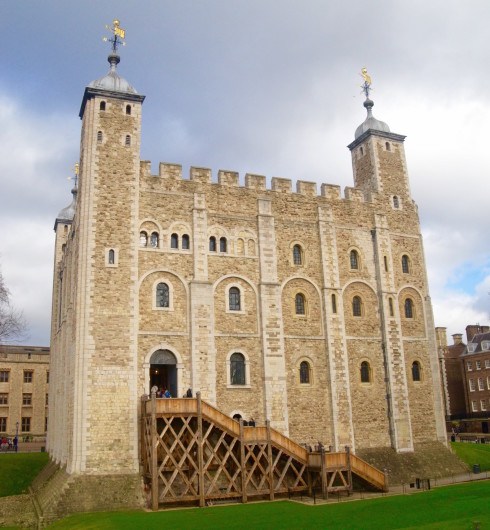
The medieval portion of the audio our focuses on the reigns of Henry III and his son Edward I who between them ruled England for almost a century. The two preferred apartments in the outer portion of the tower to William’s White Tower and today you can see a replica of Edward’s throne from whence he dispensed justice and presided over the development of English Common Law.
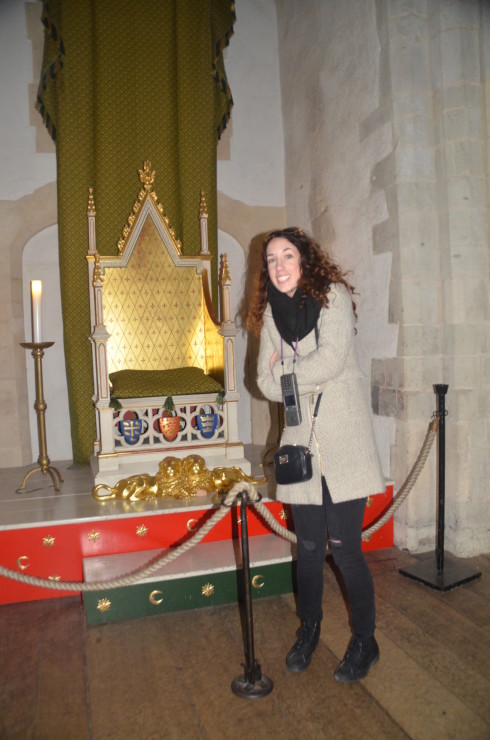
There are also actors playing the roles of Edward and his queen Eleanor of Castile, who bore him sixteen children.
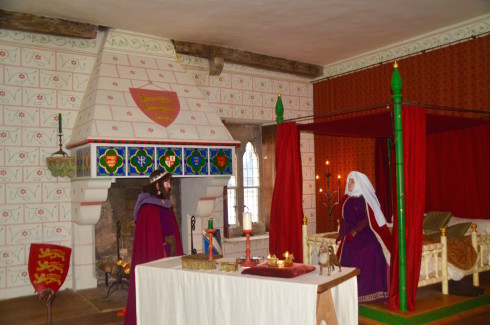
These medieval chambers have their dark side as well. Henry VI was allegedly murdered on this spot in 1471, perhaps by or on the orders of Richard, Duke of Gloucester who went on to become one of Shakespeare’s favourite villains as Richard III.
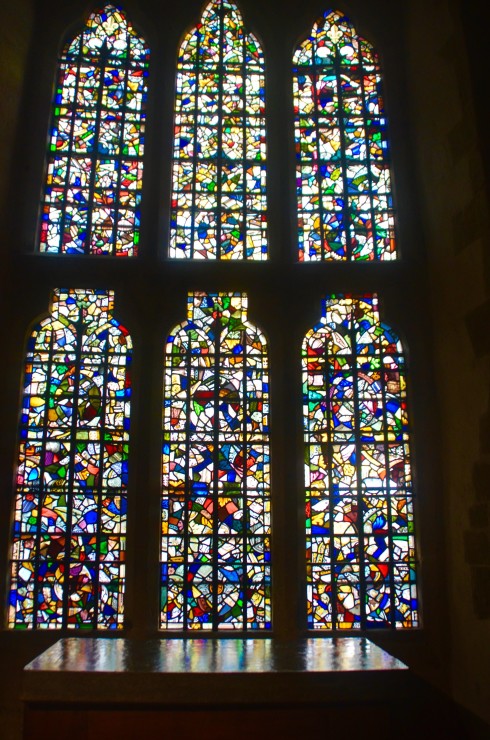
The death of Richard III at Bosworth Field (A horse! A horse! My kingdom for a horse!) brought about the long dynasty of the Tudors who used the Tower of London more as a prison and an armoury, than a residence. Time now to visit the White Tower and see some of those weapons and arms including the most famous of them all, Henry VIII’s suit of armour with its ridiculous metal codpiece. Talk about Small Penis Syndrome! There were so many people wanting their pictures taken with it that I had to borrow this one from Wikipedia.
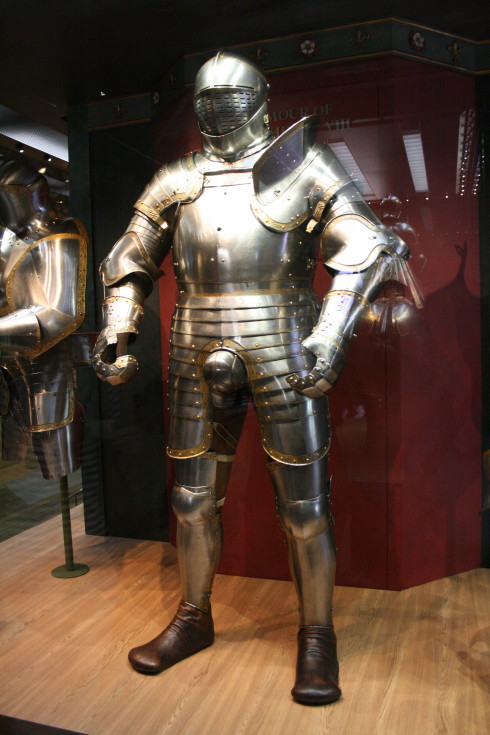
Just in case England is ever attacked again by an army of pikemen, there is a ready supply of cuirasses on hand to go around.
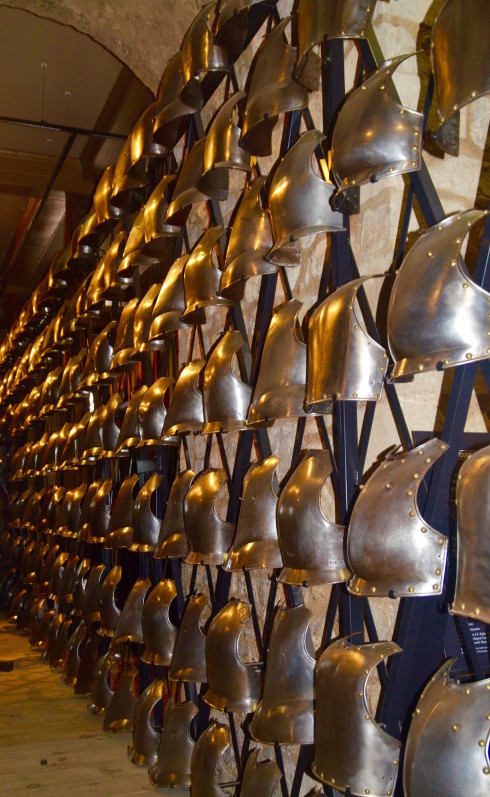
And then there’s this guy – a golden lion of St. Mark apparently captured in Corfu. The look on his face seems to be saying ” No, it wasn’t me who peed on the floor” With that golden halo, you’d almost believe him.
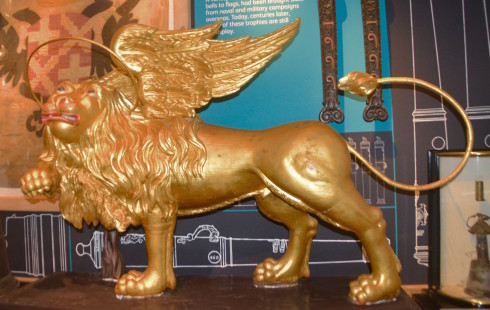
Time now to visit some the darker places in the Tower of London – the cells where prisoners whiled away their time scratching out graffiti on the bare walls. In the Beauchamp Tower it’s everywhere and some of it is very artistic like this one from a guy named Peverel.

Then there’s the next stop at The Rack. There’s days that my back is so bad that I think a turn on the rack might do it some good. Get the kinks out, no? Actually torture was very seldom used in the Tower of London.
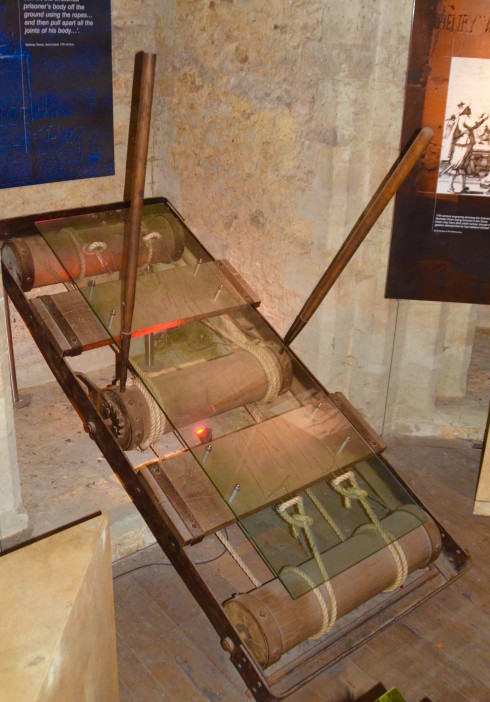
After confessing, there really was only one more stop.
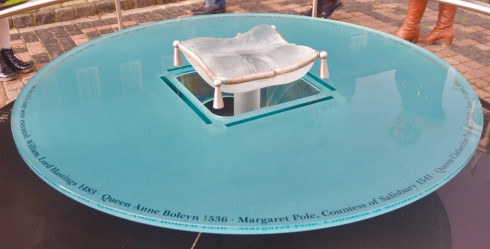
So that’s the Tower of London from start to finish. Oh wait! I forgot. The Crown Jewels are supposed to be the crown jewel of a visit to the tower right? Yes and no. It is simply impossible to absorb the fact that you are being whisked by billions of dollars worth of jewels on a moving sidewalk. They are dazzling to say the least, but I suspect most people find them anticlimactic. The history of this place is so overwhelmingly and important to the development of everything that is England, that whether the jewels were kept here or under the Queen’s mattress wouldn’t diminish the reason why this is an absolute A list attraction and should be on everyone’s bucket list.
For another way to see the Tower of London take one of the Thames River boats that are part of the London transportation system. You’ll see not only the Tower, but many other famous London landmarks from a new perspective.

